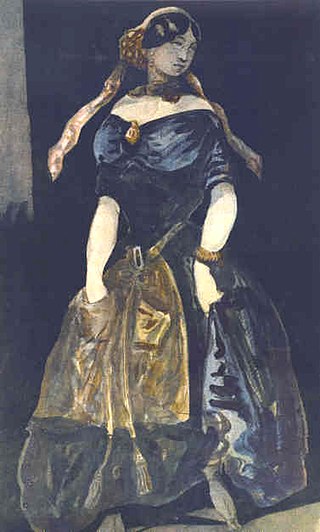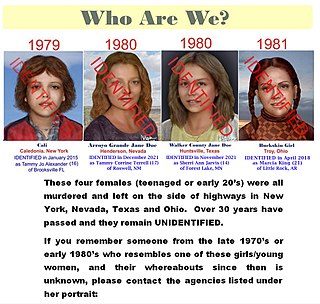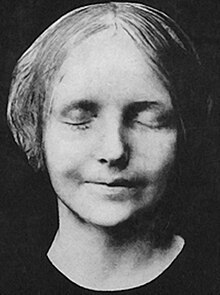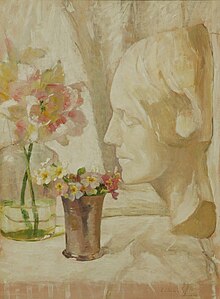Robert Florey was a French-American director, screenwriter, film journalist and actor.

La Llorona is a vengeful ghost in Mexican folklore who is said to roam near bodies of water mourning her children whom she drowned in a jealous rage after discovering her husband was unfaithful to her. Whoever hears her crying either suffers misfortune or death and their life becomes unsuccessful in every field.

Perfume: The Story of a Murderer is a 1985 literary historical fantasy novel by German writer Patrick Süskind. The novel explores the sense of smell and its relationship with the emotional meanings that scents may have.
Unknown or The Unknown may refer to:

Laerdal is a multinational company that develops products and programs for healthcare providers, voluntary organizations, educational institutions, hospitals, and the military worldwide. Laerdal has over 2,000 employees in 26 countries. The headquarters is located in Stavanger, Norway.

A death mask is a likeness of a person's face after their death, usually made by taking a cast or impression from the corpse. Death masks may be mementos of the dead or be used for creation of portraits. The main purpose of the death mask from the Middle Ages until the 19th century was to serve as a model for sculptors in creating statues and busts of the deceased person. Not until the 1800s did such masks become valued for themselves.

Pola X is a 1999 French drama film directed by Leos Carax and starring Guillaume Depardieu, Yekaterina Golubeva and Catherine Deneuve. The film is loosely based on the Herman Melville novel Pierre: or, The Ambiguities. It revolves around a young novelist who is confronted by a woman who claims to be his lost sister, and the two begin a romantic relationship. The film title is an acronym of the French title of the novel, Pierre ou les ambiguïtés, plus the Roman numeral "X" indicating the tenth draft version of the script that was used to make the film.

La Seine no Hoshi is Japanese anime series by Soeisha, which premiered in Japan on Fuji TV from April 4, 1975 and finished its run on December 26, 1975, spanning a total of 39 episodes. The title translates to English as "The Star of the Seine" or "The Seine's Star". It is based on Alain Delon's 1964 movie The Black Tulip.

Sadako Yamamura is the main antagonist of Koji Suzuki's Ring novel series and its eponymous film series. Her backstory varies between continuities, but all depict her as the vengeful ghost of a young psychic who was murdered and thrown into a well. As a ghost, she is dressed in a simple white dress with long black hair hiding her face, and uses nensha, her most distinctive power, to create a cursed videotape; whoever watches the tape will be haunted by Sadako and die exactly one week later unless the tape is copied and shown to another person, who must then repeat the same process. The titular "ring" from the novels and films refers to a ring-like visual that appears on the cursed videotape, which actually depicts the top of the well as seen by Sadako from its bottom. Korean and American films reimagine the character as Park Eun-seo (Korean: 박은서) and Samara Morgan respectively, with similar backgrounds and features.

The word grisette has referred to a French working-class woman from the late 17th century and remained in common use through the Belle Époque era, albeit with some modifications to its meaning. It derives from gris and refers to the cheap grey fabric of the dresses these women originally wore. The 1694 edition of the Dictionnaire de l'Académie française described a grisette as simply "a woman of lowly condition". By the 1835 edition of the dictionary, her status had risen somewhat. She was described as:
...a young working woman who is coquettish and flirtatious.
Necrophilia has been a topic in popular culture.

Erik is the titular protagonist of Gaston Leroux's novel Le Fantôme de l'Opéra, best known to English speakers as The Phantom of the Opera. The character has been adapted to alternative media several times, including in the 1925 film adaptation starring Lon Chaney, the 1943 remake starring Claude Rains, the 1962 remake starring Herbert Lom and Andrew Lloyd Webber's 1986 musical.

A White Lady is a type of female ghost. She is typically dressed in a white dress or similar garment, reportedly seen in rural areas and associated with local legends of tragedy. White Lady legends are found in many countries around the world. Common to many of these legends to consist of the woman going in to insanity and killing her own kids and once realizing is an accidental or impending death, murder, or suicide and the theme of loss, betrayed by a husband or fiancé, and unrequited love.

Resusci Anne, also known as Rescue Anne, Resusci Annie, CPR Annie, Resuscitation Annie, Little Annie, or CPR Doll is a model of medical simulator used for teaching both emergency workers and members of the general public. Resusci Anne was developed by Norwegian toy maker Åsmund S. Lærdal, Austrian-Czech physician Peter Safar, and American physician James Elam, and is produced by the company Laerdal Medical. Anne is rumored to be modeled after a dead woman who died in the Seine.

Guillaume Musso is a French novelist. He is one of the most popular contemporary French authors.

Act of Love is a 1953 American romantic drama film directed by Anatole Litvak, starring Kirk Douglas and Dany Robin. It is based on the 1949 novel The Girl on the Via Flaminia by Alfred Hayes. A Parisian falls in love with an American soldier near the end of World War II.

Reinhold Conrad Muschler aka Reno Muschler, was a German botanist, explorer and writer, who worked on the taxonomy of North African flora. He travelled extensively with Ernest Friedrich Gilg (1867–1933) and carried out a revision of the flora of Patagonia. His parents were both well-known singers at the Court Opera in Berlin.

Unidentified decedent, or unidentified person, is a corpse of a person whose identity cannot be established by police and medical examiners. In many cases, it is several years before the identities of some UIDs are found, while in some cases, they are never identified. A UID may remain unidentified due to lack of evidence as well as absence of personal identification such as a driver's license. Where the remains have deteriorated or been mutilated to the point that the body is not easily recognized, a UID's face may be reconstructed to show what they had looked like before death. UIDs are often referred to by the placeholder names "John Doe" or "Jane Doe". In a database maintained by the Ontario Provincial Police, 371 unidentified decedents were found between 1964 and 2015.

Hanna Berger was an Austrian dancer, choreographer, teacher, director, theatre director, writer and lifelong anti-Nazi and communist. She was described as part of the free dance movement.

The Unknown is a 1936 German drama film directed by Frank Wisbar and starring Sybille Schmitz, Jean Galland and Ilse Abel. The film's sets were designed by the art directors Benno von Arent and Artur Günther. Location shooting took place around Berlin, Stuttgart and Dinkelsbühl in Bavaria. It was inspired by the Unknown Woman of the Seine and based on a novel by Reinhold Conrad Muschler.




















